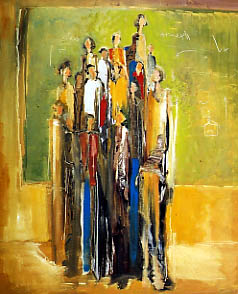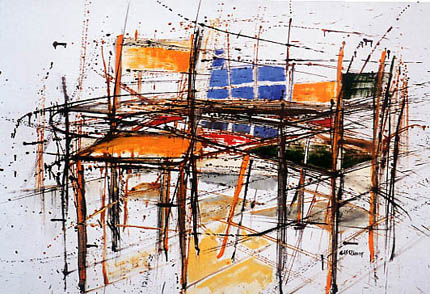

Andros Efstathiou presents his new work at the Gallery Morfi on November 27 until December 7, 2001.
Efstathiou (born 1964) has recently (October 2001) represented Cyprus at the Alexandria Biennale, and in December, he will participate in the Florence Biennale. In February - March 2002, he will have a one-man exhibition in Copenhagen.
Art historian, Dr. Antonis Danos writes of Efstathiou's exhibition at Morfi:
`Strong references to 20th century modernist art are made manifest within the latest work by the painter Andros Efstathiou, creatively transposed and adapted into his own vision. These references could be loosely connected with two main sources in the modernist tradition.
The FIRST regards the colouristic explosion that was brought about by movements early in the century, such as Fauvism and, especially, German Expressionism. Large, heavily coloured surfaces make up Efstathiou's interior spaces, sturdily constructed, and inhabited by deformed figures, loosely sketched in colour. The dominant theme in these pictures is that of the school classroom, in which several, often tiny, student figures are uniformly - one might say, mass-like - portrayed. On the contrary, teachers are extremely tall figures, rendered in giacomettian distortion, thus accentuating the awe that is inspired by the often monumentally constructed spaces.
The contrast of the small, homoeomorphous student figures to the vastness of their surroundings, as well as to the size of the teachers, might well be interpreted as a protest against the "levelling" nature of school education. If so, however, it is a protest constructed with purely aesthetic, or "painterly", rather than conceptual, means, thus the power of these pictures. Part of their appeal is, moreover, owed to their ambiguity: they may well be "read" as memories, or subconscious residue, from early schooling years.
The coloured rectangles in some of the pictures point, additionally, to the abstract paintings by Mark Rothko (1903-1970), from the middle of the 20th century. Rothko's works are normally situated within American Abstract Expressionism, which is where the SECOND source for Efstathiou's work can be traced, particularly to the works of Jackson Pollock (1912 - 1956). The pictures by Efstathiou, with the repeated motive of the chairs (which is also present within the "classroom" pictures, but here is seen autonomously), echo Pollock's "dripping" method, appropriated here in a loose , even playful manner, and adapted to figurative painting, in contrast to the completely abstract compositions of the American artist.
Perhaps the most successful appropriation, by Efstathiou, of this tradition is offered by a couple of his paintings, where the structure of Pollock`s large, "drip" pictures is used for the portrayal of a crowd of children, where the theme of schooling is repeated via the numerous, tiny student figures and the dominant, totemic presence of the teacher - lined up, as if ready for a school photo.
In general, Efstathiou's work constitues a brilliant example of fertile appropriation of sources from modernism's tradition, without any intention of mere copying, or superficial reproduction. On the contrary, the sources have been creatively adapted in images that appear as intriguing scrapings from the artist's memory, yet imbued with perennial and universal qualities that make these paintings substantial works of art.`